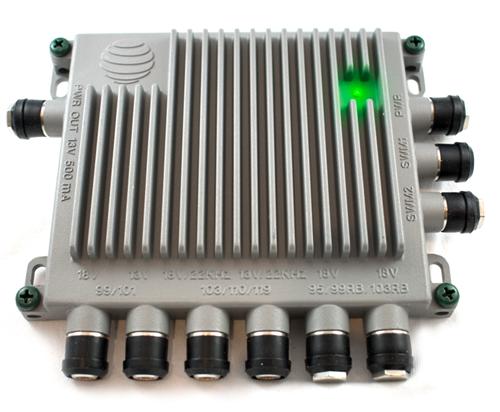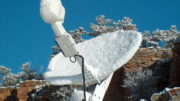The SWM-30 multiswitch you see above isn’t for everyone. It’s a specialized tool for larger installations. Whether you work commercail stuff or just average DIRECTV equipment, you need to know what to expect when setting up your system. You’ll need a signal meter like our AIM Advanced Installation Meter to test.
Why not use the signal meters built into the receiver?
Signal levels are measured in dBm at the frequencies used by DIRECTV satellite systems. The signal meters in DIRECTV receivers don’t show dBm. They show something like the inverse of the bit error rate. (Yeah, I know, that’s a mouthful.) What they are trying to show you is how much of the “good” signal gets to the receiver, not how strong that signal is. While that’s important — perhaps more important than raw signal strength — you still need good strong signals throughout the cable run.
Remember that with DIRECTV signals, dB numbers are negative, measuring from -1 to -100 (typically.) So numbers like -50 are very low and numbers like -20 are high. That’s hard to get used to, but eventually it makes sense. dBs are also logarithmic, meaning that a loss of 3dB means a 50% cut in signal and a loss of 10dB means a 90% cut in signal.
What’s a good power level at different points?
Power levels at the dish can vary wildly depending on your location. However, the LNB itself does normalize the signal somewhat. If this is an installation with a separate multiswitch, you are generally ok using the built-in amplifiers on the SWM but if you measure less than -45dBM (in other words like -60) at the input point of the multiswitch you may want to consider the use of an amplifier. Remember that you can’t amplify a SWM signal, so all amplification must take place before the SWM. This will let you put the SWM close enough to the receivers that no amplifier is needed.
Whether it’s a simple SWM-enabled dish or a fancy multiswitch, look for signals to be around -25 to -28dBm at the exit of the multiswitch (or dish.) If the number is higher (like -21) that indicates a problem with the internal amplification and could be due to faulty equipment. If you are using an adjustable external amplifier you may choose to turn down the level.
As the signal travels down the cable it loses strength. There are several great signal loss calculators out there. (This one at net-comber.com works well without a lot of extra clutter.) If you reach the point where the signal is -45dBm or less (in other words like -60) at the receiver you will begin to have problems on rainy days when the signal is noisier. If it’s below -60dBm you’ll probably have problems with video and audio dropping out.
What amplifier should you use?
The STA trunk amplifier from AT&T is the only approved amplfiier for DIRECTV signals. If you find an older amplifier in an installation, you don’t have to replace it. Just know that when it does fail, the STA is your go-to choice.
There is no recommended amplifier for SWM signals. All amplification should be done before the multiswitch, and the multiswitch should be placed so that every receiver gets good signal. If this isn’t possible with one multiswitch, use a second one at a second location. Yes this will mean quite a bit more cabling but it really is worth it to avoid problems down the road.
Working with a satellite meter, it should be possible to figure out where the problems lie and address them so your whole system works as expected. This will help repeat visits to the home or business for problems with picture and sound.





